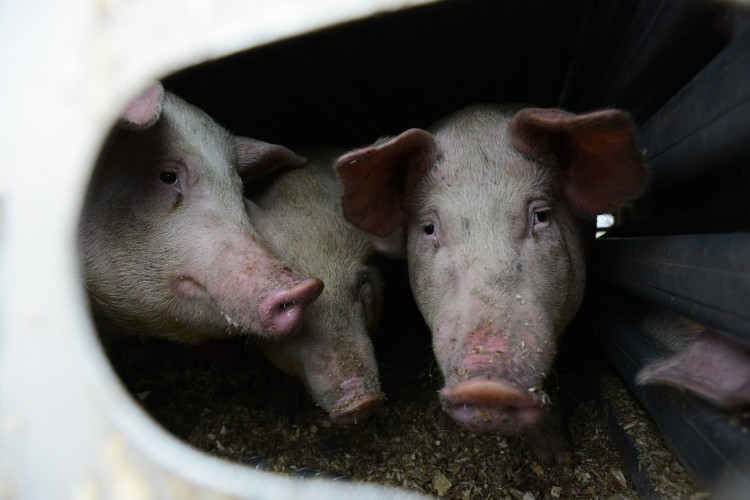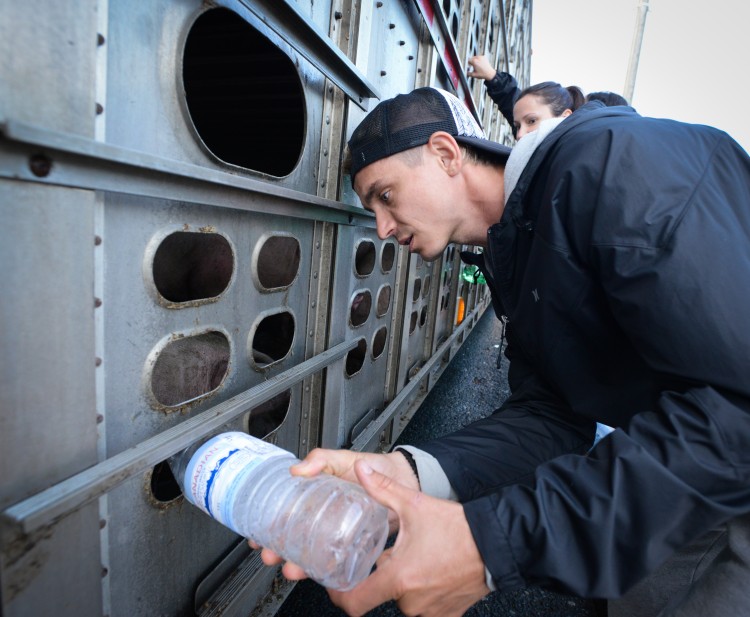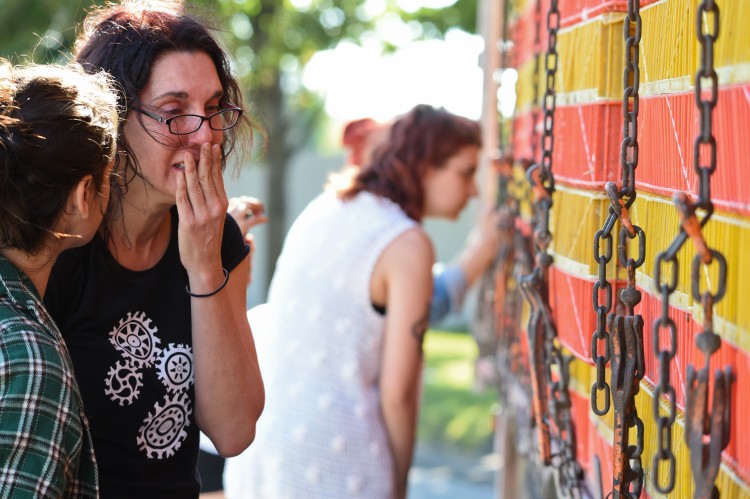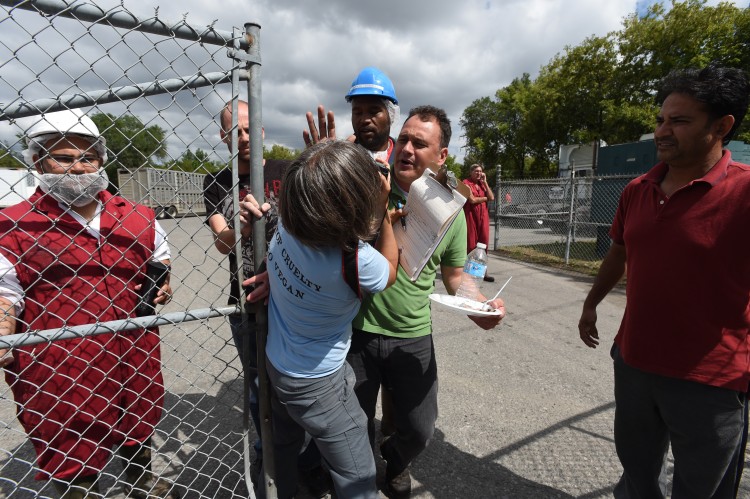So much human-caused animal suffering goes on every day largely because people turn a blind eye to it. People are encouraged constantly to turn away from a real consideration of animal lives and deaths, either because they are hidden from them entirely, or through convincing themselves that animals don’t actually suffer or that their suffering doesn’t matter. What would it mean for systems of animal abuse and exploitation if instead of looking away, we turned towards animals who were suffering? Could this form of bearing witness be a force for change and a form of activism?
Harnessing the power of bearing witness to animal suffering is the foundation of the organization Toronto Pig Save, and The Save Movement it inspired, which now has over 660 chapters all over the world. I had a conversation with The Save Movement’s founder, Anita Krajnc, to discuss what bearing witness looks like, how it helps animals, and why she considers it an ethical duty.
Dylan Forest: Can you tell me about how you got started in founding Toronto Pig Save, which in turn inspired the global Save Movement? How did your first vigil come about, and how did it grow from that point?
Anita Krajnc: Toronto Pig Save started in December 2010 after we adopted Mr. Bean, a dog. We would walk along Toronto’s Lakeshore each morning and that was when I first witnessed pigs looking out of the portholes of transport trucks heading to Quality Meat Packers, a slaughterhouse in downtown Toronto. A group of us assembled and held monthly organizing meetings and vegan potlucks to discuss plans to build our base. We organized art shows and did investigative work to capture footage at the slaughterhouse for half a year before we launched our weekly vigils in July 2011.

I studied and taught a social movements course at Queen’s University a few years earlier, and I drew on that experience by staging frequent nonviolent direct actions and using a love-based community organizing approach. The first pig I witnessed up close in a transport truck in the summer of 2011 looked back into my eyes and pleaded for their life. It was obvious that the right thing to do was to rescue him/her, but I couldn’t. It was awful. I made a promise to the pig that we would hold at least three vigils a week. We kept that promise. The idea of vigils and bearing witness as a community was so powerful and easily replicable that groups started forming near and far away. Our goal is to hold vigils at every slaughterhouse until they all shut down!
What is bearing witness, and what does bearing witness look like for Toronto Pig Save?
Bearing witness is best defined by Leo Tolstoy in his early 20th century book A Calendar of Wisdom: “When the suffering of another creature causes you to feel pain, do not submit to the initial desire to flee from the suffering one, but on the contrary, come closer, as close as you can to him who suffers, and try to help him.”
We bear witness at animal vigils in front of slaughterhouses. On principle, we feel it’s important to go to these sites of animal injustice as a community and to be there for the animal victims and invite the world to not look away. The idea behind the animal vigils is that if everyone bore witness, people en masse would engage in Gandhian noncooperation by not consuming animal body parts and animal products.
Surprisingly, there are slaughterhouses in or near many cities. Alternatively, there are usually live markets, auctions and factory farms nearby. Some Save Movement chapters hold vigils at cow dairy farms, and some go to animal auctions and protest there, as animals at auctions are sold to slaughterhouses. In some cities, like New York City, there are vigils at live markets.

Why do you believe bearing witness is important? What does it do for the humans who are doing it, and what does it do for the animals?
I think bearing witness is an ethical duty we all share. When someone is suffering from egregious injustice in your community, in your backyard, you have a duty to find that location, to go there and try to help and to invite everyone to join you to stop the injustice. At Save Movement vigils, our form of bearing witness is always partial. At most we rescue a few animals at some vigils (100s of animals have been rescued worldwide at our vigils), but we don’t do what the animals want, which is to rescue them all, including their friends and family.
We try to help people go vegan and to prevent future breeding and animal exploitation and, increasingly, we are planning and developing campaigns to advocate just, plant-based, food system change. Our campaigns sometimes target individual slaughterhouses and animal feed companies like Maple Leaf Food and Cargill. We are trying to build a mass movement and public support so that we can end animal agriculture and fishing and reforest the earth to reverse climate chaos.

Do you have any thoughts on the potential trauma experienced by humans who are bearing witness? Is there anything that can be done to reduce this possibility, particularly in the interest of activist self-care?
I think it’s very difficult to bear witness mainly because we are not helping the animals before us in the way they are asking us to. If we were able to free them all it would be less traumatic. What helps though is that we have other impacts, such as building the movement so more people bear witness first-hand and become vegans and activists, and helping more people see our social media and mass media coverage. We also offer each other support when we bear witness as a community. We do have self-help tips and community assistance offered by a psychologist. On this topic we recommend Patrice Jones’ book Aftershock.
In 2015, you were charged with criminal mischief for giving water to pigs who were being transported to slaughter. In 2017 you were found not guilty, which I imagine may have set a precedent for the legality of the activities of The Save Movement. Do people still try to stop your actions and vigils, legally or otherwise? Do you feel as if the law is on your side, or is there still a threat of legal action?
The Pig Trial was a partial victory, as it set the precedent that compassion is not a crime! Giving water to thirsty animals is not criminal mischief! But Judge Harris ruled that pigs are property. That was hugely disappointing as he could have paid greater attention to the arguments of my two vegan lawyers and four expert witnesses on the sentience of pigs, the climate crisis and public health issues.

Animal activists have a right to free expression and to hold animal vigils in front of slaughterhouses, live markets, auctions and animal farms. We have a right to bear witness and to try to convince the public and governmental and societal institutions to switch from animal protein to plant-based foods to save animals, the environment and human health. One of the issues we run up against at some slaughterhouses is transport trucks trying to push past protesters so we can’t bear witness. In such situations we demand that the police and slaughterhouse managers take action with a safety agreement. They can immediately change the culture from one of violence and antagonism towards activists to one where the right to bear witness is accepted as the norm. It allows for amicable relations and sitting together to talk about transitioning towards a plant-based food system.
Is there anything else you’d like to add?
Please join us. Bearing witness is an ethical duty. If we follow our purpose in life and live a life of service, we live a fulfilled life. It may be difficult and a sacrifice to bear witness, but as animal lovers, helping animals and ecosystems survive is the most profound thing we can do in our short time on this planet.
Learn more about Toronto Pig Save on their website or Facebook page. The Save Movement now has over 660 groups worldwide; visit their website to find one near you or to learn about how to start your own.
Featured image: an activist touches a pig’s snout in a transport truck during a Toronto Pig Save vigil. Image credit Jo-Anne McArthur / We Animals.





